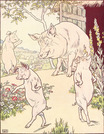
In Unit 6, students use their procedural knowledge of multiplication and division with whole numbers, combined with their newly acquired understanding of multiplication and division with fractions, to multiply and divide with decimals, reasoning about the placement of the decimal point. They then apply this to the context of word problems, including those involving measurement conversion.
This unit starts with multiplying a decimal by a single-digit whole number, then multiplying a decimal by a multi-digit whole number, and finally multiplying a decimal by another decimal. Then, students progress to dividing a decimal by a single-digit whole number, then dividing a decimal by a two-digit whole number, and finally solving cases involving decimal divisors. Throughout these topics, students use the same methods to compute decimal products and quotients as they did for whole-number products and quotients, but they must reason about the placement of the decimal point. It is only in the last lesson of each topic that students generalize the pattern of the placement of the decimal point. The various lines of reasoning, and their advantages and disadvantages, can be read on pages 19 and 20 of the NBT Progression linked in the “Unit-Specific Intellectual Preparation” section. Students also solve myriad word problems as well as write and solve expressions involving decimals as a way to support the major work (5.OA.1, 5.OA.2). Finally, the unit closes with students learning to convert among different-sized customary measurement units within a given measurement system and solve word problems that use those conversions (5.MD.1), which extends the work from Grade 4 of converting from a larger unit of measurement to a smaller one in Grade 4 (4.MD.1—2). As noted in the Progressions, “this is an excellent opportunity to reinforce notions of place value for whole numbers and decimals, and the connection between fractions and decimals (e.g., meters can be expressed as 2.5 meters or 250 centimeters)” (GM Progression, p. 26), as well as computations with these types of numbers (5.NBT.7, 5.NF), thus connecting the work of unit conversion with major work of the grade.
Reasoning about the placement of the decimal point affords students many opportunities to engage in mathematical practice, such as constructing viable arguments and critiquing the reasoning of others (MP.3) and looking for and expressing regularity in repeated reasoning (MP.8). For example, “students can summarize the results of their reasoning as specific numerical patterns and then as one general overall pattern such as ‘the number of decimal places in the product is the sum of the number of decimal places in each factor’” (NBT Progression, p. 20).
- Subject:
- Mathematics
- Material Type:
- Assessment
- Homework/Assignment
- Lesson Plan
- Unit of Study
- Provider:
- Match Fishtank
- Date Added:
- 01/01/2017
